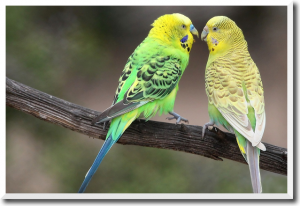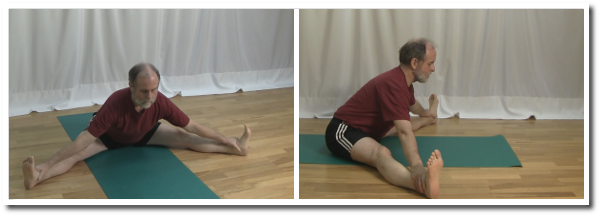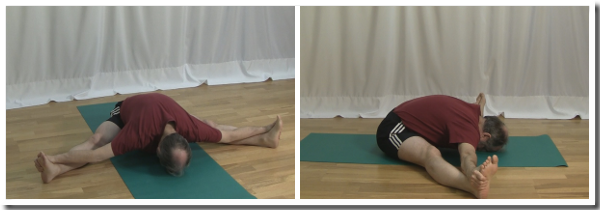Rupert, the green English Budgie glides across the room. He lifts his ribs, brings his hips forward and lands gently on the branch.
Alice noticed that Rupert landed the same way that her yoga teacher wants her to move into so many yoga poses, lead with her hips. Just the other day he was admonishing her to lead with her hips in Konasana.
What is Konasana
Konasana is the last seated pose of the Primary Series of Ashtanga yoga. Its full name in Sanskrit is Upavistha Konasana and it is pronounced (oo-pah-VEESH-tah cone-AHS-anna). Upavistha means seated or sitting and Konasana means angle. The common English name for this pose is Wide Angle Seated Forward fold because you fold forward with your legs spread wide apart.
Konasana stretches the abductor muscles and hamstrings in your legs. At the same time it is strengthens the spine and works on stretching the muscles around your hip joint. And as you fold forward and down in the pose you are massaging and stimulating your abdominal organs. You only get these benefits if your get some good alignment in place.
How to do Konasana
Like most seated poses you start in Dandasana, seated on your mat with your legs together and straight out in front of you. Your torso is tall, your hands are resting on your mat beside your hips and your gaze is to the horizon.
— First setup your legs
From Dandasana you move your legs wide apart until they are about 90 degrees apart. Do not move your legs apart further even if you can. The maximum benefit is derived from the pose when your legs are at a right angle to each other.
Move your feet to a vertical position and point your toes straight up into the air and draw your toes back towards your hips.
While you are getting your feet setup, turn your knees inwards so that they also point up to the ceiling.
Now that your legs are ready it is time to move on to your hips.
— Next get your hips ready
Your hips should still be sitting up tall on the mat like they were in Dandasana. Now bring your hands directly behind your hips on to your mat. Using your hands to assist you tip the top of your hips forward and drag your hips and legs forward slightly. This movement will shift your weight forward onto the front of your sitz bones in preparation for the forward fold that is coming next.
— Now bring your torso forward and down
Move your hands from behind your hips and bring them forward along your legs while you lower your torso down towards your mat.
Eventually your torso will be laying on your mat between your legs and your hands will be holding the little toe sides of your feet.
Once you have finished moving as forward as possible bring your gaze down your nose and hold here for several breaths.
To get the most benefit from the pose and to protect your lower back like Rupert the English Budgie you lead with your hips.
Why lead with your hips
When you lead with your hips in the pose you are protecting your lower back from injury. Moving the top of your hips forward first helps to maintain the natural curves in your spine as you fold forward and down towards your mat.
Lead with your hips to protect your lower back and stretch your hips.
There is a technique to help insure that you are leading with your hips.
How to make sure you lead with your hips
When we fold forward in this pose we tend to let our lower back round so we can get our shoulders closer to the ground. Rounding your lower back causes stress in the muscles of your lower back and gives your hips a break.
To avoid this problem copy the movement that Rupert the budgie did as he approached the branch. He lifted his ribs and brought his hips forward. Alice copies Rupert and leads with her lower ribs as she folds forward. This movement insures that her hips are getting the most benefit.
Bring your awareness to your lower ribs and the top of your abdomen. When you fold forward imagine taking your lower ribs forward away from your hips rather than down towards your mat. This movement will straighten out your spine protecting your lower back and it will also force the top of your hips to move forward as well.
As soon as you focus on your lower ribs in this forward fold you will notice that your hips are getting a lot more involved and you will also notice that you are not folding as far forward.
But I don’t fold as far forward as I did before!
You were getting your shoulders and head closer to the floor because you were allowing your back to round.
Focusing on moving your ribs forward will protect your lower back and work on increasing flexibility in your hips. Your head and shoulders will be further from the floor but your back will be protected from injury and you will be working on stretching your hip muscles even more.
Continue focusing on moving your ribs forward and soon you will move closer to the mat once again.
Summary
Rupert leads with his hips when he comes in for a landing on the branch and Alice is working on leading with her hips when she moves into Konasana. Alice will eventually land her torso on her mat as her hips become more flexible. In the meantime Alice will continue to lead with her lower ribs to work on improving the flexibility in her hips and thighs while protecting her lower back from injury.
Next Step
Ask your yoga teacher to check your back in Konasana. A rounded lower back will let your hips escape the stretching that they need and can cause you to injure your lower back muscles.
Additional Reading
In How to use the steam engine to find your edge you can learn more about your edge and how to use it in your yoga practice.






